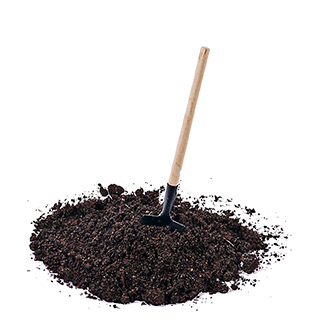The Amazing World of Composting
Posted on November 30, 2014 by bob in Yard 'N Garden
My wife and I bought a house in 1999 with a very large back yard. There were a number of mature oaks, with much of the yard in deep shade. Due to lack of light, competition from tree roots, and damage from the previous owner’s dogs, there were large areas with no grass. Even worse, the top soil had washed away over the years leaving a subsoil consisting of a hard-packed clay/gravel mix that, while excellent road bed material, was useless for growing even shade-tolerant grass.
Using composted organic matter to improve soil quality is an age-old technique. For many centuries it was about the only way to do so. Over the years a variety of other techniques emerged, including the well-know compost pile – created simply by putting waste vegetative matter into a large pile and periodically turning it until it decomposes into compost. The process was improved by using bins or containers to concentrate the heat generated by decomposition and to retain moisture. Use of green manure — planting a cover crop, then plowing it into the soil and letting it decompose there — is another old-time method. All of these techniques, however, are fairly labor intensive, and I am not a labor intensive guy. But back to my yard problem.
Each autumn I was presented with a huge volume of oak leaves, which I gathered with the mower, piled up, and composted. My wife, not pleased with the big piles of leaves sitting in the back yard, bought some fancy composting bins which sped up the process. I dug up a patch to plant vegetables, and utilizing the compost, converted the hard packed subsoil into a soft, crumbly soil that absorbed water quickly and was very easy to work. But spading up the rock hard clay, breaking up the clods, and mixing in large amounts of compost was hard work. Using this method to improve the large areas with no grass or topsoil would require lots of physical labor.
I considered buying a power tiller or bringing in a couple of truckloads of topsoil, but dismissed these as they still required a high level of physical exertion. Finally, I found a method that appealed to me. I discovered a small composting book by Stu Campbell, Let It Rot! Home Gardeners’ Guide to Composting, which discussed several methods of composting, including one I’d never heard of — sheet composting.
Sheet composting consists of depositing a thick layer of leaves, grass clippings, and other organic matter evenly over a fairly large area, and allowing these items to decompose, adding new material every year, replicating what occurs naturally on a forest floor. Leaves in excess of what would fit in my compost bins were dumped and scattered over the area. During the summer, grass clippings were dumped and scattered as well. No other activity was needed. For a lazy man, what could be better?
Year after year, leaves and grass clippings were added. Amazingly, the depth of un-decomposed material never reached more than three to four inches. It seemed the more material I added, the faster it decomposed, leaving the duff and humus. When I dug into the soil, I was amazed to find the humus only about two inches deep, and the clay in the subsoil radically transformed. No longer just red, the clay had darkened up to eight inches deep, greatly due to the organic matter dramatically improving the soil.
My next step is to seed the area with a shade tolerant variety of St. Augustine grass, which still has to compete with the oak tree roots and thrive with limited sun. But at least now the soil will be receptive to grass roots, and the roots will have a fighting chance.
Intern classes to become a Master Gardener begin in February. For more information call 270-4133.
Andy Jackson, a Master Gardener in the Capital City Master Gardener Association, lives in Montgomery. For information on becoming a master gardener, visit the website, www.capcitymga.org or e-mail capcitymga@gmail.com.










